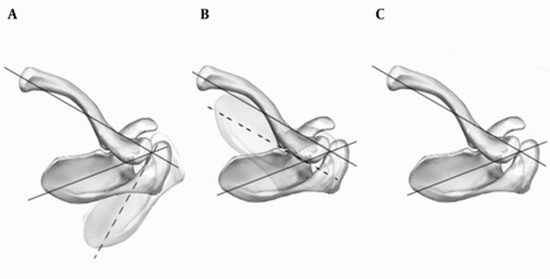Dynamic Comparison of Segmentary Scapulohumeral Rhythm Between Athletes With and Without Impingement Syndrome
The main purpose of this study was to measure and compare the segmentary scapulohumeral rhythm (SSHR) during scapular arm elevation at a steady rotational speed in athletes with and without impingement syndrome

Background:
Patients who have shoulder pain usually have compensatory or contributory deviation of shoulder motion during arm elevation. In the traditional scapulohumeral rhythm, the share of the acromioclavicular (AC) and the sternoclavicular (SC) joint movements and also the role of AC internal rotation angle are unknown.
Objectives:
The main purpose of this study was to measure and compare the segmentary scapulohumeral rhythm (SSHR) during scapular arm elevation at a steady rotational speed in athletes with and without impingement syndrome.
Patients and Methods:
Using a speedometer, the maximum speed of arm elevation was measured in 21 men in each of the involved and uninvolved groups. Using fluoroscopy on the dominant side, SSHR during scapular arm elevation at a rotational speed equal to 1/30 of maximum speed was compared between the two groups. The ratio of glenohumeral (GH) elevation angle to AC rotation angle in the scapular plane was considered as SSHR.
Results:
The maximum speed of arm elevation between the two groups was significantly different (P < 0.001). The rhythm of the involved group significantly exceeded the rhythm of the uninvolved group in a part of the first quarter range of the arm elevation. SSHR during arm elevation in the uninvolved group did not change significantly (P = 0.845); however, it decreased significantly in the involved group (P = 0.024).
Conclusions:
Speed differences between the two groups were probably due to the pain in some ranges of arm elevation. SSHR in the involved group probably changed in order to compensate downward rotation of the scapula in the resting position. Study of the AC upward rotation range can be misleading; therefore, the study of scapulohumeral rhythm is recommended.






ارسال به دوستان